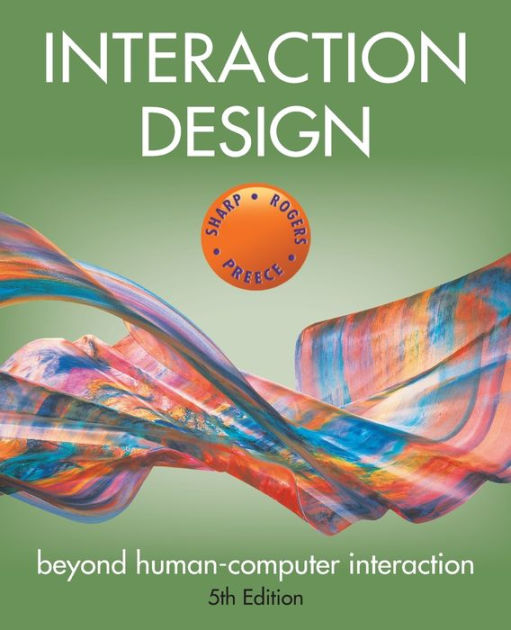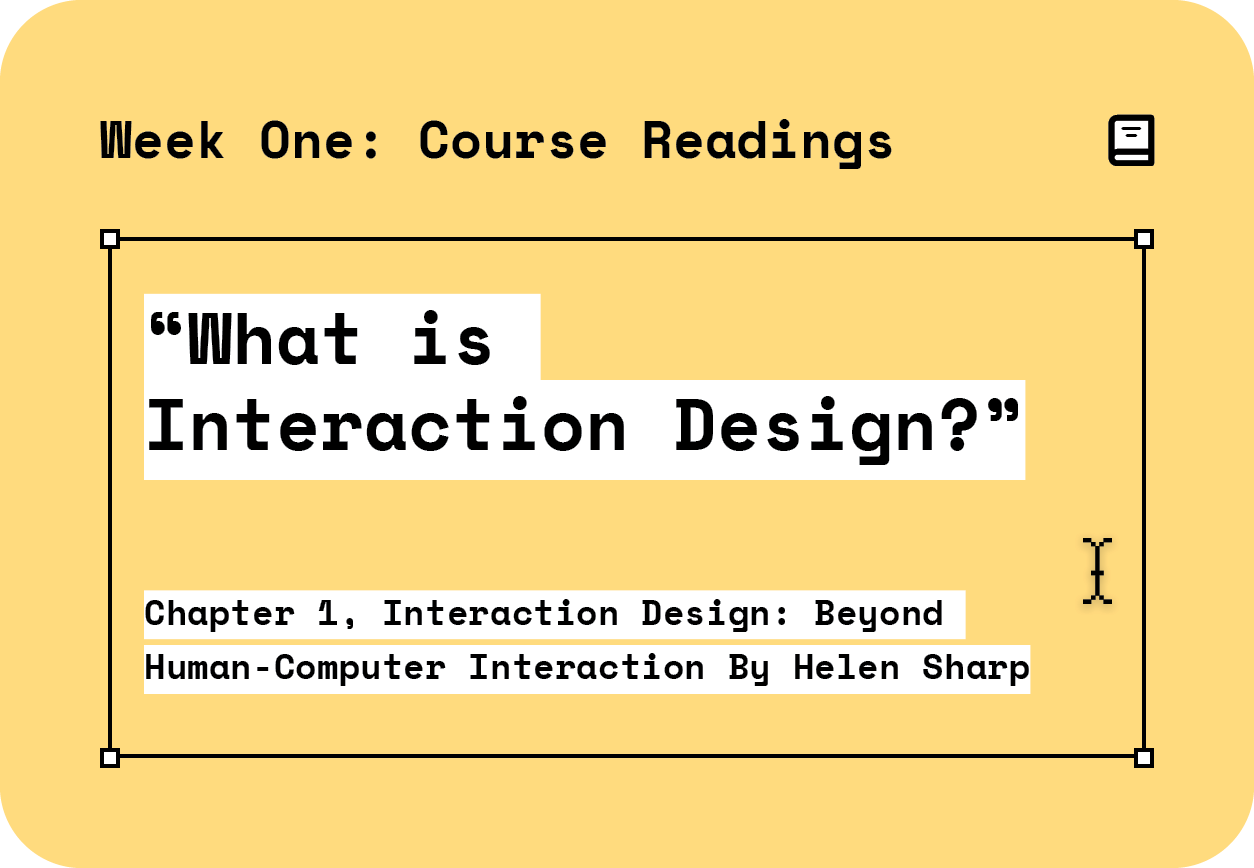Taking more of a textbook format, this first chapter from Interaction Design: Beyond Human-Computer Interaction explores the overarching discipline of Interaction Design. Used as a overarching term to describe the methods, theories, and approaches used in the discipline, Interaction design is the catch-all term used to describe the “different aspects of what is being designed including user interface design (UI), software design, user-centered design, product design, web design, user experience design, and interactive system design.“
More generally, it is a term used to describe the process of:
“Designing interactive products to support the way people communicate and interact in their everyday and working lives. Put another way, it is about creating user experiences that enhance and augment the way people work, communicate, and interact.”
In industry, Interaction design & User Experience (UX) are used interchangeably, though UX is more widely used to refer to the profession.
What’s clear after reading this chapter is that the term ‘Interaction Design’ is a lot less buzz-wordy than ‘User Experience’ and as a result seems to offer a much clearer academic lens for understanding the discipline. The terms scope also seems a lot broader than the popular use of ‘User Experience’ which seems to have become deeply intertwined with the very trendy and specific fields of app design, UI design, Customer Experience (CX) and Service Design (as judged by recent job listings).
Interaction Design is about designing holistic interaction experiences, ones that bridge the gap between human behaviours and the increasingly wide-spread use of technologies to supplement a wide range of activities. As a result, Human-Computer-Interactions (HCI) are becoming omni-present in our everyday lives, many of us using multiple interactive products everyday (kettle, toaster, oven, washing machine, smartphone, laptop), all of which necessitate interaction design to make each of these interactions “easy to learn, effective to use, and providing an enjoyable user experience”. Its important to note that “one cannot design a user experience, only design FOR a user experience.” The use of ‘UXD’ attempts to specify the Design aspect of User Experience.
The Chapter goes on to begin to describe various Conceptual frameworks, tried and tested design methods, guidelines, and relevant research findings. The importance of Understanding Users is explored, especially how differences in language, social norms, and ability can impact someones interaction experience. Accessibility and inclusiveness particularly stood out to me as an valuable design consideration which is important to consider from the beginning of the design process and not as an after thought.
Finally, six Usability Goals and five Design Principles are elaborated:
Usability goals
These are a “means of assessing various aspects of an interactive product and the user experience.” They are usually framed as contextual question that help designers notice things early in the design process.
1. Effective to use (effectiveness) – this usability goal refers to how effective a product is at full-filling its purpose – that is to say, it does what it was intended to do.
Framed as a Question: “Is the product capable of allowing people to learn, carry out their work efficiently, access the information they need, or buy the goods that they want?”
2. Efficient to use (efficiency) – this usability goal refers to how a product facilitates the user fulfilling their task and whether it does so as efficiently as possible – that is to say, without unnecessary steps and as streamlined as possible. A great example of an efficient product is Amazons patented ‘One-Click’ button, which simplifies the online-shopping experience down to the most fundamental interactions. Framed as a Question: “Once users have learned how to use a product to carry out their tasks, can they sustain high levels of productivity?
3. Safe to use (Safety) – this usability goal refers to the behavioural interaction with a product. It considers protecting users from dangerous conditions and undesirable situations by factoring appropriate safe-guards and fail-safes to protect users from physical harm, as well as undesirable consequences of accidental actions. With interactive products, this involves protecting users from making serious errors (i.e. not putting quit and save buttons right next to each other) and providing users with various methods of recovery should they make an error (i.e. undo buttons). “Safe interactive systems should engender confidence and allow the user the opportunity to explore the interface top try new operations. Framed as a Question: “What is the range of errors that are possible using the product, and what measures are there to permit users to recover easily from them?”
4. Utility – this usability goal refers to a product having the appropriate features to maximise functionality for the intended use case. An example of a product having good utility is an e-commerce website that includes a ‘similar products’ listing, allowing users browsing an item to see related items which might suit their needs better. Frames as a Question: ” Does the product provide an appropriate set of functions that will enable users to carry out all their tasks inthe way they want to do them?”
5. Learnability – it is generally understood that users don’t enjoy spending longe periods learning how a new product/system works. They want to be competent at using a product for its intended purpose with as little barriers as possible. This usability goal refers to how easy a product is to learn. An example of good learnability were the games included in early operating system versions that encouraged people to learn to use a mouse while playing. Frames as a Question: “Is it possible for the user to work out how to use the product by exploring the interface and trying certain actions? How hard will it be to learn the whole set of functions this way?”
6. Memorability – this usability goal refers to how memorable using a product is, especially those products used less frequently. If users haven’t used a product in a while, they should be able to rapidly relearn how to use it. This can be aided by breaking tasks down into smaller, simpler to understand steps or by organising interfaces in logical structures which are simple to remember. Examples of good memorability would be datings apps like Tinder that use simple gestures to express intention (left is no, right is yes), while examples of poor memorability might include spreadsheet software that is highly capable but relies on a long lift of specific function terms that need to be applied correctly to achieve the desired outcome. Framed as a Question: “What types of interface support have been provided to help users remember how to carry out tasks, especially for products and operations they use infrequently.”
Design Principles
Similar to the principles described by Don Norman, these principles a derived from a mix of theory-based knowledge, experience, and common sense to outline what users should see and do when using interactive products.
1. Visibility – relates to how legible the interactive and functional aspects of a product are. Is it intuitive for the user to interpret what actions they need to take? An example of this is interactive taps that use invisible motion sensors to operate, often times making it difficult for users to understand what actions they need to take to achieve their desired outcome of running water.
2. Feedback – relates to the responding flow of information in response to an interaction. An example is haptic feedback of a phone when a virtual button is pressed to indicate an interaction has been registered and function performed. Feedback is important as it provides registration information in response to an action being taken. An example of poor feedback includes pedestrian cross-walk button (beg buttons) that don’t indicate when they’ve been pressed, often times leading to users pressing an repressing buttons in frustration.
3. Constraining – refers to limiting the sets of actions that are possible to the user to only those that are appropriate or suitable for the interaction. One of the advantages of constraining interactions is that it prevents users from selection incorrect options and thereby limiting the possibility of the user making mistakes. Constraints can be made on User Interfaces (by greying out options), interpretations of graphics (by visually connecting objects), and physical (by using unique plugs for different cables).
4. Consistency – relates to establishing a framework for interaction, one which uses similar ways interacting for achieving similar functionality. A great example is the use of ‘right-clicks’ to bring up a contextual menu in computer operating systems; in different instances, this action brings up different options but the action is the same and consistently is a way for the user to access additional functions relevant to their current view. Consistency is important as it simplifies the amount of actions users need to perform by creating a structured logic to achieve their intentions.
5. Affordances – this is described as being the possible relationship that can exist between a user and a designed object. An affordance is the perceived uses a person has for a design. Since it describes a relationship between a design and a person the affordances available for one person might be different for another (i.e. affordances will be different for someone who is abled-bodied person vs. someone who is differently abled).

Chapter Notes from Reading:
Interaction Design: Beyond Human-Computer Interaction By Helen Sharp
